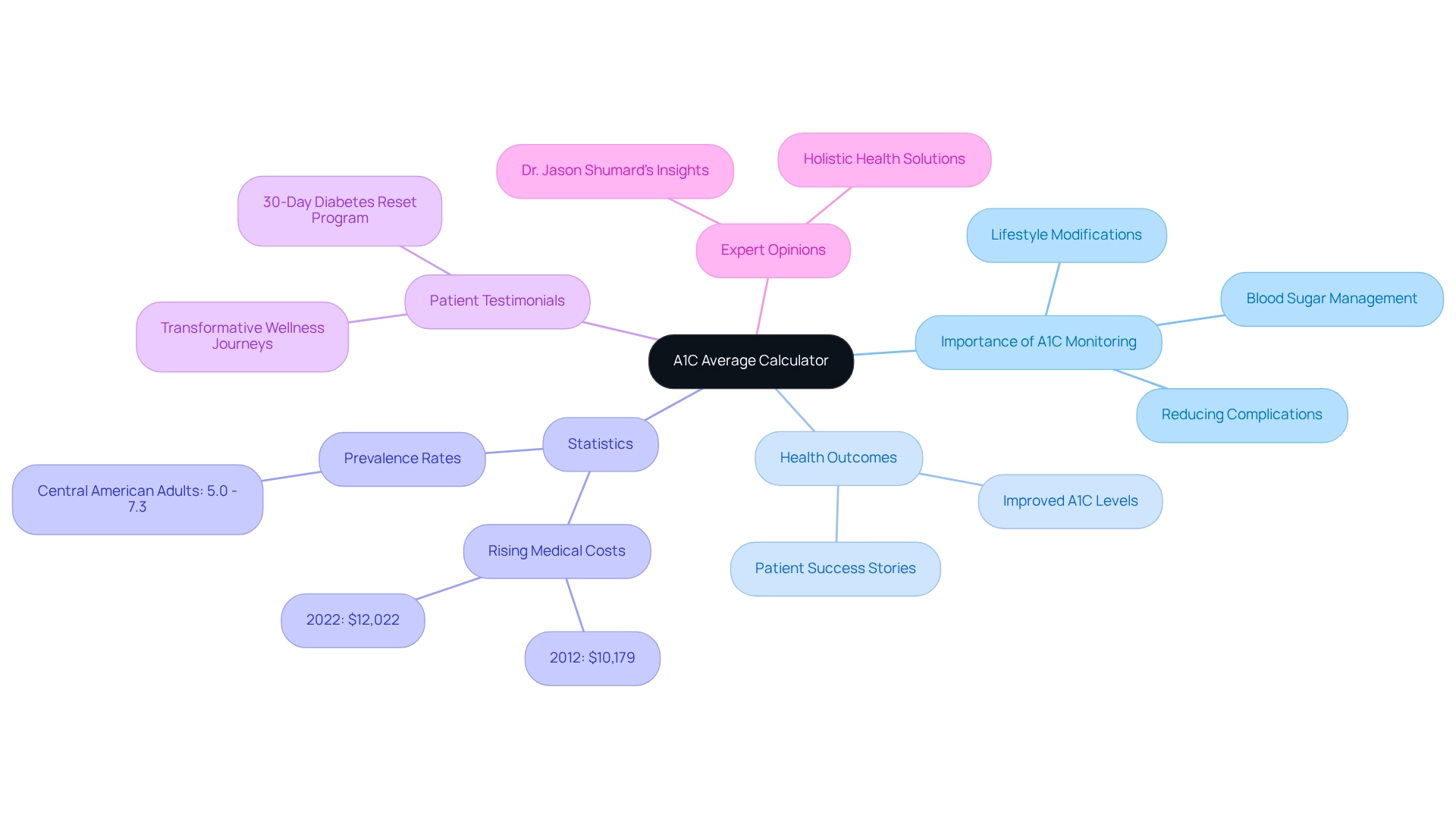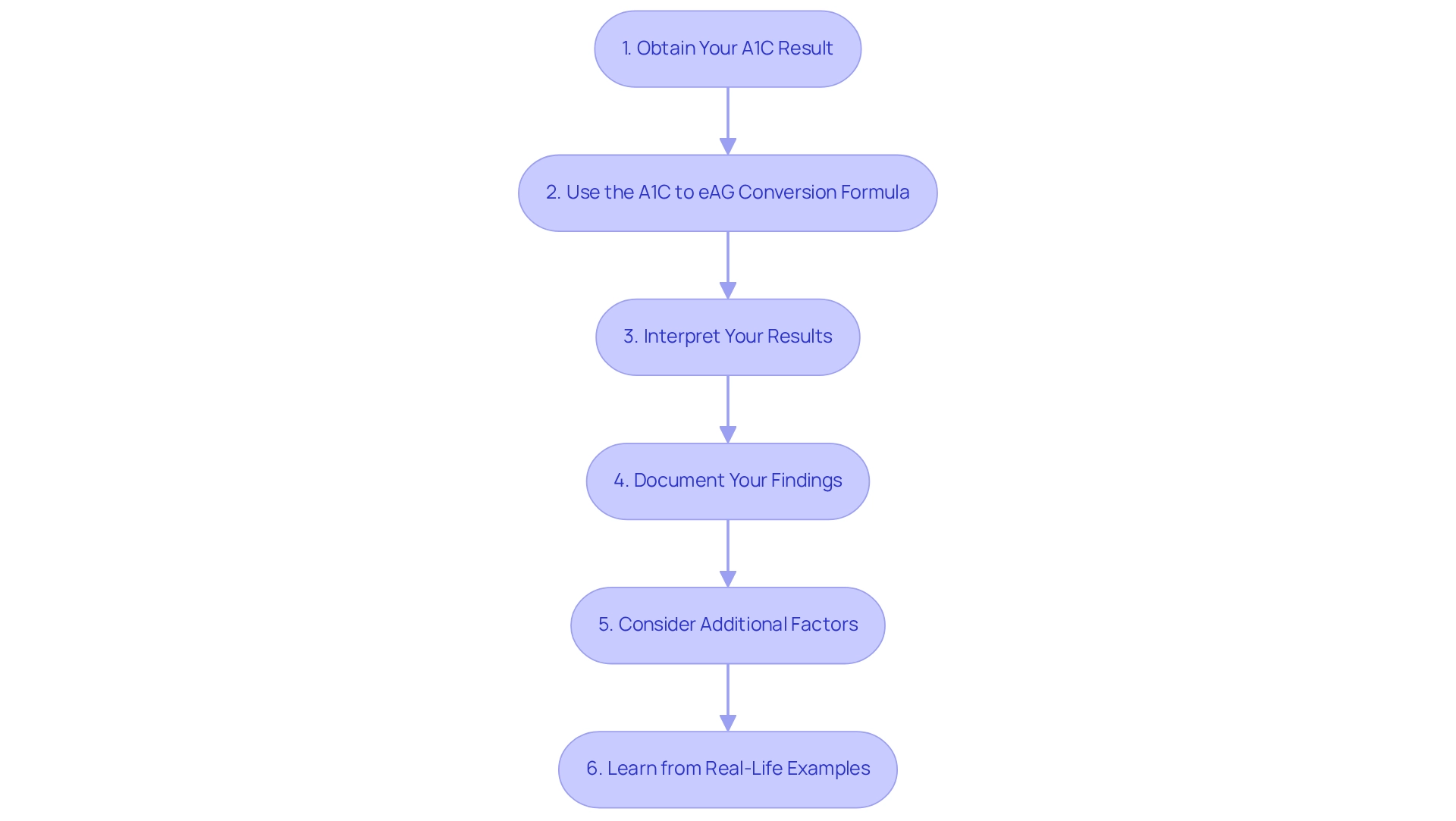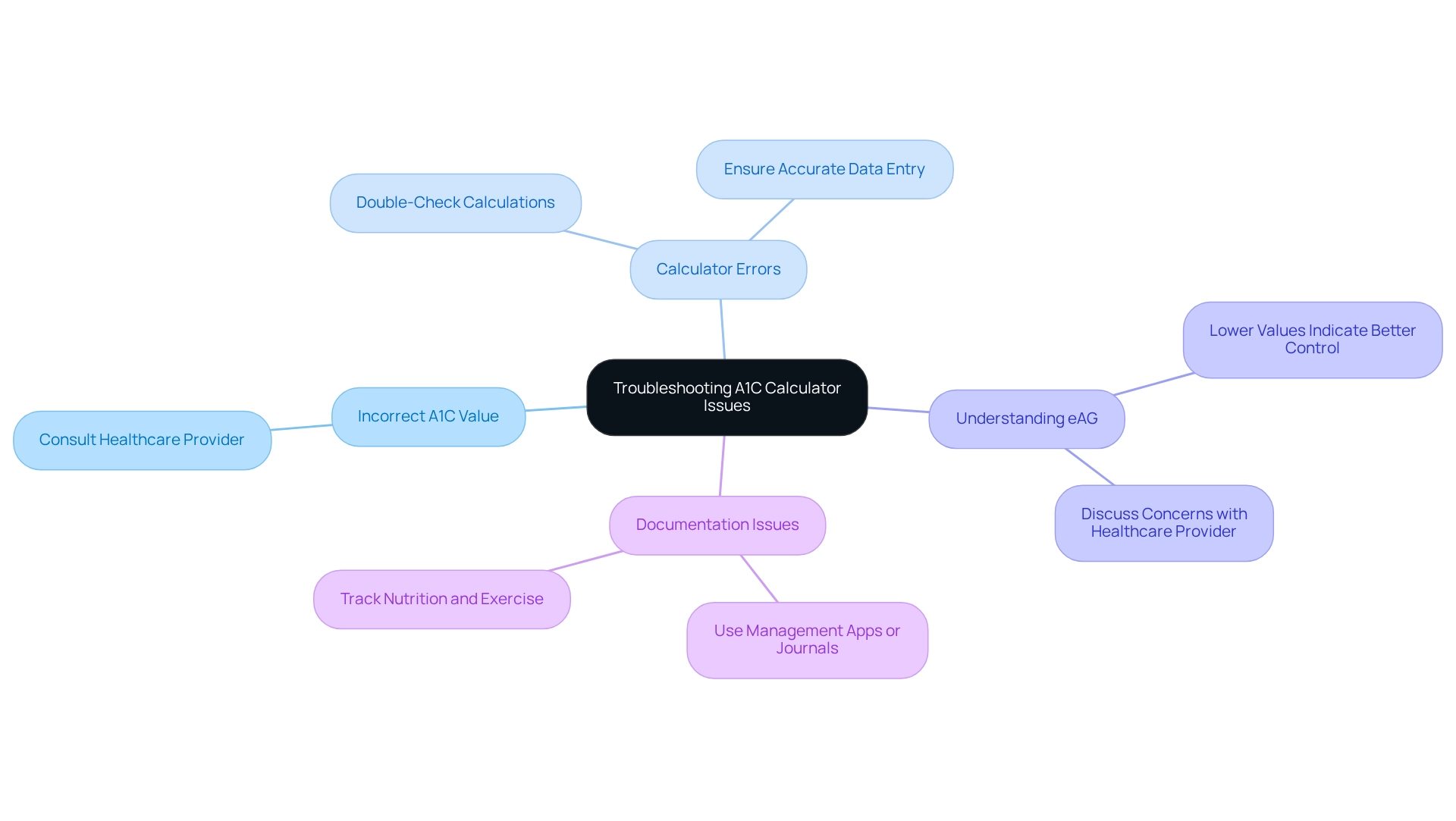Overview
Managing diabetes can be a challenging journey, and understanding your A1C levels is a crucial step toward effective care. The A1C average calculator serves as an essential tool, offering insights into your average blood glucose levels over the past two to three months. By monitoring these levels, you can track your progress and make necessary adjustments to your treatment plan.
It’s important to recognize that consistent tracking of A1C levels can lead to improved health outcomes and significantly reduce the risks of complications. Many patients find that by staying informed, they can take proactive steps in their health journey. Real-world success stories and expert insights highlight just how impactful this tool can be in managing diabetes, providing not only data but also hope and encouragement.
As you explore this resource, remember that you are not alone. Embracing this knowledge can empower you to take control of your health and inspire positive changes. Consider how this tool might fit into your daily routine and support your overall well-being.
Introduction
In the journey of managing diabetes, it’s essential to recognize the role of the A1C Average Calculator as a vital tool for those striving for better health. This important resource not only estimates average blood glucose levels over a two to three-month period but also acts as a key indicator of overall glucose control. Many patients find that mastering this calculator can significantly reduce the risk of complications related to diabetes, such as heart disease and kidney issues.
By tracking their progress, individuals can make informed adjustments to their treatment plans. As healthcare professionals emphasize the importance of A1C monitoring, real-life success stories remind us of the transformative impact personalized strategies can have on managing diabetes, paving the way for improved health outcomes and a renewed sense of well-being.
Understand the A1C Average Calculator and Its Importance
Understanding the a1c average calculator is vital for effective blood sugar management. This essential tool calculates average blood glucose readings over the past two to three months, based on A1C test results. The A1C test measures the percentage of hemoglobin in the blood coated with sugar, offering a comprehensive view of overall glucose control. For individuals grappling with blood sugar challenges, using the a1c average calculator is crucial, as it aids in monitoring progress and adjusting treatment plans accordingly. A lower A1C percentage signifies improved blood sugar control, significantly reducing the risk of diabetes-related complications, such as heart disease, kidney damage, and neuropathy.
It’s important to recognize that consistent tracking of A1C readings empowers patients to make essential lifestyle modifications, leading to better health outcomes. Current statistics reveal that complications related to elevated A1C levels are a major concern, with medical expenses linked to the condition rising from $10,179 to $12,022 between 2012 and 2022. This increase underscores the importance of A1C monitoring in preventing these expenses and effectively managing the condition. Many patients find that expert opinions emphasize the significance of A1C monitoring in managing blood sugar levels, as it indicates glucose control and guides treatment strategies. Dr. Jason Shumard states, “By offering patients practical insights and effective tools, the center cultivates an atmosphere where individuals can regain their wellness and well-being.”
Real-world examples demonstrate how consistent A1C monitoring leads to improved health outcomes for those with the condition. Patient testimonials from Dr. Shumard’s 30-Day Diabetes Reset program highlight transformative wellness journeys, showcasing how tailored functional medicine strategies have effectively supported individuals in managing their condition. One patient shared, “After starting the program, my A1C dropped from 9.1 to 5.7, and I lost 55 lbs!” The commitment to comprehensive wellness at Integrative Wellness Center shines through in these success stories, where patients have experienced significant advancements in their A1C figures and overall well-being.
By prioritizing A1C levels, patients can take proactive steps towards reclaiming their well-being and mitigating the risks associated with health issues. Understanding and utilizing the a1c average calculator empowers patients to take control of their health, aligning with Dr. Shumard’s dedication to patient education and empowerment. For more information on effectively managing your diabetes and to register for upcoming events, contact Integrative Wellness Center today!
Gather Required Tools and Prepare for Calculation
To accurately calculate your A1C average, consider using an A1C average calculator. Gather these essential tools:
- Your most recent A1C test result from your healthcare provider or lab report
- A calculator or a smartphone with a calculator app
- Optionally, a conversion chart for A1C to estimated average glucose (eAG)
This chart can be particularly helpful in understanding how your A1C levels relate to your daily blood sugar management.
It’s important to create a quiet space free from distractions to focus on your calculations. This approach not only aids in accuracy but also empowers you to take control of your health journey. Many patients find that utilizing an A1C average calculator is a crucial step in effective diabetes management. Understanding the significance of your A1C results is vital. For instance, an A1C measurement of 9.5% corresponds to 80 mmol/mol, illustrating how A1C values convert into quantifiable results. Elevated A1C levels can lead to serious medical complications, including nerve issues, eye damage, kidney disease, and heart problems. By preparing adequately, you can enhance your understanding of your condition and make informed decisions regarding your treatment options.
Incorporating effective strategies for progress tracking can significantly boost your focus and motivation in managing your diabetes. Have you considered setting SMART goals—specific, measurable, attainable, relevant, and time-bound? For example, you might aim to reduce your A1C by a certain percentage within a specific timeframe. Consistently assessing your progress not only promotes accountability but also allows you to adjust your objectives in response to evolving circumstances. Dr. Shumard emphasizes that by providing patients with actionable insights and practical tools, the center fosters an environment where individuals can reclaim their health and well-being.
Follow Step-by-Step Instructions to Calculate A1C Average
To effectively utilize an A1C average calculator, let’s walk through these steps together:
-
Obtain Your A1C Result: Begin by finding your most recent A1C percentage from your lab report. For example, if your A1C is 7.0%, take a moment to note this figure.
-
Use the A1C to eAG Conversion Formula: To convert your A1C to estimated average glucose (eAG), apply the formula: eAG (mg/dL) = (28.7 x A1C) – 46.7. For instance, with an A1C of 7.0%, the calculation would be: eAG = (28.7 x 7.0) – 46.7 = 154 mg/dL.
-
Interpret Your Results: It’s important to compare your eAG to the target range established by your healthcare provider. Generally, an eAG below 154 mg/dL indicates good control for most adults with the condition. Remember, small changes in temperature, equipment, or sample handling can affect blood glucose test results, so consistency in testing conditions is essential. This variability is crucial to consider when interpreting your results.
-
Document Your Findings: Keep a record of your A1C and eAG results to monitor your progress over time. This documentation is vital for you and your healthcare team to make informed decisions regarding your diabetes management plan. Regularly assessing your progress can foster a sense of responsibility and allow for adjustments in your goals as your fitness capabilities evolve. You might find it helpful to use fitness apps, journals, or pedometers to track your daily activities and progress.
-
Consider Additional Factors: Be mindful that conditions such as hypertriglyceridemia and vitamin B12 deficiency can lead to falsely elevated A1C levels. Understanding how these conditions affect your A1C is important for accurate monitoring. Regular consultations with your healthcare provider can help you reassess and adjust your A1C targets as your treatment goals evolve.
-
Learn from Real-Life Examples: For instance, during pregnancy, A1C testing can identify undiagnosed blood sugar issues in women with risk factors. Post-pregnancy testing is essential for those with gestational conditions to monitor the possible onset of type 2. This highlights the significance of A1C calculations in particular patient groups.
By following these steps and establishing SMART goals—specific, measurable, attainable, relevant, and time-bound—you can gain clearer insights into your condition management and make informed choices about your health. In San Marcos, CA, consider utilizing local parks and community wellness programs to support your journey. Remember, whether you’ve been living with this condition for years or you’re recently diagnosed, you deserve to have experts you can trust.
Troubleshoot Common Issues and Questions
When using an A1C average calculator, it’s common to encounter a few challenges. Here are some supportive tips to help you navigate these issues:
-
Incorrect A1C Value: It’s important to verify that you are using the correct A1C percentage from your latest test. If you’re unsure, don’t hesitate to consult your healthcare provider for clarification.
-
Calculator Errors: Remember to double-check your calculations. If you’re utilizing an A1C average calculator app, ensure that all numbers are entered accurately to avoid any miscalculations.
-
Understanding eAG: If interpreting your estimated Average Glucose (eAG) results feels confusing, keep in mind that lower values indicate better blood sugar control. For personalized guidance, discussing any concerns with your healthcare provider can be very helpful.
-
Documentation Issues: Keeping track of your results can be a challenge. Consider using a management application or a journal to record your A1C and eAG values, along with notes on your nutrition and workout routines. This practice not only helps in tracking your progress but also aids in recognizing patterns that may influence your blood sugar readings.
Incorporating holistic lifestyle strategies can significantly enhance your management of these conditions. Embrace the outdoor lifestyle in San Marcos by engaging in regular exercise at local parks and trails, which can improve insulin sensitivity and help control weight. Focusing on a balanced diet rich in local produce, such as avocados and berries, can assist in regulating blood sugar levels. Furthermore, participating in community wellness initiatives can provide invaluable support and resources tailored for effectively managing blood sugar levels.
It’s essential to be aware of the potential dangers of elevated insulin levels, which can lead to various health issues, including weight gain, heart disease, and insulin resistance. By addressing these common concerns and integrating lifestyle adjustments, you can deepen your understanding of your A1C calculations with the help of an A1C average calculator and enhance your overall health management. As Dr. Jason Shumard emphasizes, “By providing patients with actionable insights and practical tools, the center fosters an environment where individuals can reclaim their health and well-being.” Supporting organizations like the American Diabetes Association is also crucial for ongoing research and resources that benefit all diabetes patients.
Conclusion
Understanding and utilizing the A1C Average Calculator is a crucial step in managing diabetes effectively. This essential tool not only helps estimate average blood glucose levels over time but also serves as a key indicator of overall glucose control. By regularly monitoring A1C levels, individuals can track their progress and make informed adjustments to their treatment plans, significantly reducing the risk of complications such as heart disease and kidney damage.
It’s important to recognize that the process of calculating A1C averages involves clear steps that empower patients to take control of their health. From gathering the right tools to interpreting results accurately, each stage plays a vital role in effective diabetes management. Many patients find that real-life success stories underscore the transformative impact of personalized strategies in achieving better health outcomes. With dedication and the right resources, significant improvements in A1C levels and overall well-being are indeed achievable.
Ultimately, prioritizing A1C monitoring fosters a proactive approach to diabetes management, encouraging individuals to reclaim their health. By understanding the significance of their A1C results and implementing holistic lifestyle changes, patients can navigate the complexities of diabetes with confidence. As healthcare professionals continue to emphasize the importance of A1C tracking, it becomes clear that mastering this tool is not just about numbers; it’s about empowering individuals to lead healthier, more fulfilling lives.
Frequently Asked Questions
What is the purpose of the A1C average calculator?
The A1C average calculator helps calculate average blood glucose readings over the past two to three months, based on A1C test results, which measure the percentage of hemoglobin in the blood coated with sugar.
Why is monitoring A1C levels important?
Monitoring A1C levels is crucial for effective blood sugar management, as a lower A1C percentage indicates improved blood sugar control and reduces the risk of diabetes-related complications, such as heart disease, kidney damage, and neuropathy.
How can consistent tracking of A1C readings benefit patients?
Consistent tracking of A1C readings empowers patients to make essential lifestyle modifications, leading to better health outcomes and potentially preventing complications associated with elevated A1C levels.
What statistics highlight the importance of A1C monitoring?
Medical expenses related to elevated A1C levels increased from $10,179 to $12,022 between 2012 and 2022, underscoring the importance of A1C monitoring in managing diabetes and preventing related costs.
What do patient testimonials reveal about A1C monitoring?
Patient testimonials from Dr. Shumard’s 30-Day Diabetes Reset program demonstrate that consistent A1C monitoring can lead to significant improvements in health outcomes, with individuals reporting drops in A1C levels and weight loss.
How does the Integrative Wellness Center support patients in managing their diabetes?
The Integrative Wellness Center emphasizes patient education and empowerment, offering practical insights and effective tools to help individuals regain their wellness and manage their diabetes effectively.
Where can individuals find more information about managing their diabetes?
Individuals can contact the Integrative Wellness Center for more information on effectively managing diabetes and to register for upcoming events.



